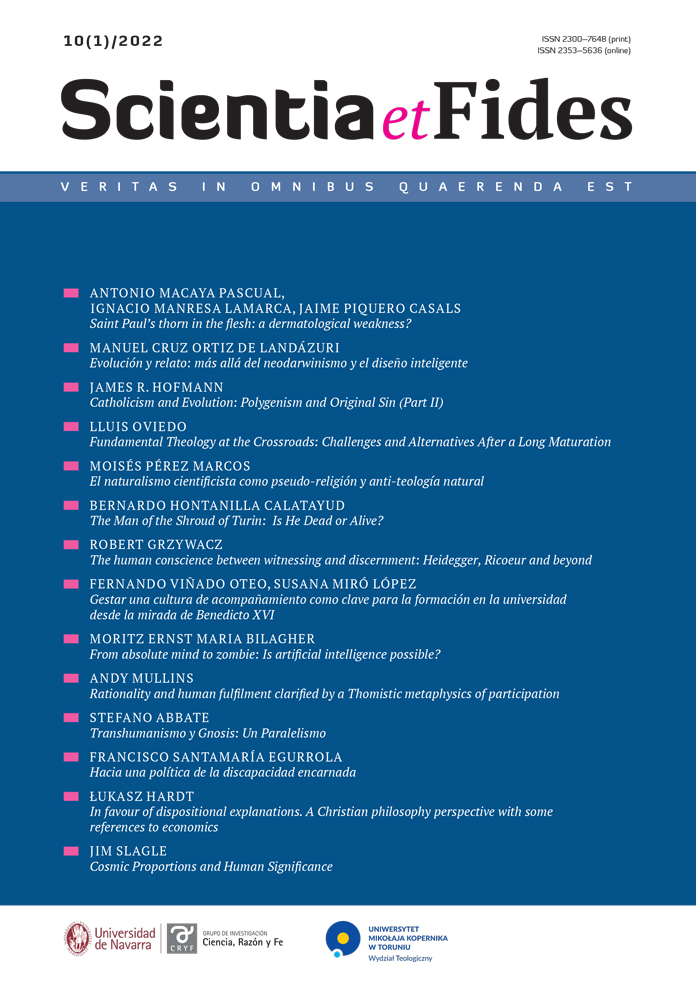Cosmic Proportions and Human Significance
DOI:
https://doi.org/10.12775/SetF.2022.013Słowa kluczowe
medieval cosmology, size, value, PtolemyAbstrakt
A common misperception, both within academia and without, is that the premodern, Judeo-Christian picture of the universe was of a small, cramped one. This allowed people to believe that the Earth and its inhabitants were the most important thing in it. But this misfires in several ways: First, the premodern cosmos is only small in comparison to what contemporary science has discovered, not absolutely. Second, the premoderns felt just as insignificant as we do in light of the universe’s size, but we cannot translate this into a scientific or philosophical argument. Third, it assumes that the Judeo-Christian view is that humanity is the most important thing (rather than God) and that God created the universe for us (rather than himself). Fourth, whatever value human beings have in the Judeo-Christian tradition is derivative, based on being created in God’s image, and the size of the universe has no bearing on it.
Bibliografia
Aquinas, Thomas. 1952. Summa Theologica, translated by the Fathers of the English Dominican Province, revised by Daniel J. Sullivan. Great Books of the Western World, vol. 19: Thomas Aquinas, I. Chicago, etc.: Encyclopædia Britannica, Inc.
Aristotle. 1952. On the Soul, translated by J.A. Smith. Great Books of the Western World, vol. 8: Aristotle, I. Chicago, etc.: Encyclopædia Britannica, Inc.
Boethius. 1918. The Consolation of Philosophy, translated by S.J. Tester. The Loeb Classical Library, vol. 74: Boethius. Cambridge, MA: Harvard University Press.
D’Evelyn Charlotte and Anna J. Mill, eds. 1967. South England Legendary, vol. 2: Text, reprint. Oxford: Oxford University Press.
Everitt, Nicholas. 2004. The Non-Existence of God. New York and London: Routledge.
Giostra, Alessandro. 2021. “Theology and Science in Copernicus’s Universe.” Scientia et Fides 9 (1): 131–47. DOI: https://doi.org/10.12775/SetF.2021.004.
Goldstein, Bernard R. 1967. “The Arabic Version of Ptolemy’s Planetary Hypotheses.” Transactions of the American Philosophical Society, n.s., 57 (4): 3–55.
Hawking, Stephen. 1988. A Brief History of Time: From the Big Bang to Black Holes. New York, etc.: Bantam.
Koyré, Alexandre. 1957. From the Closed World to the Infinite Universe. Baltimore: Johns Hopkins Press.
Lewis, C.S. 1960. Miracles: A Preliminary Study, 2nd ed. Glasgow: Fontana.
Lewis, C.S. 1964. The Discarded Image: An Introduction to Medieval and Renaissance Literature. Cambridge: Cambridge University Press.
Nietzsche, Friedrich. 1873 [2005]. “On Truth and Lies in a Nonmoral Sense,” edited and translated by Daniel Breazeale. In Truth: Engagements across Philosophical Traditions, edited by José Medina and David Wood. Malden, 14–25. MA: Blackwell.
Pascal, Blaise. 1670 [2005]. Pensées, edited and translated by Roger Ariew. Indianapolis: Hackett.
Ptolemy. 1952. The Almagest, translated by R. Catesby Taliaferro. Great Books of the Western World, vol. 16: Ptolemy, Copernicus, Kepler. Chicago, etc.: Encyclopædia Britannica, Inc.
Reppert, Victor. 2003. C.S. Lewis’s Dangerous Idea: In Defense of the Argument from Reason. Downers Grove, IL: InterVarsity.
Sagan, Carl. 1997. Pale Blue Dot: A Vision of the Human Future in Space. New York: Ballantine.
Van Helden, Albert. 1986. Measuring the Universe: Cosmic Dimensions from Aristarchus to Halley. Chicago: University of Chicago Press.
Pobrania
Opublikowane
Jak cytować
Numer
Dział
Licencja
Prawa autorskie (c) 2022 Jim Slagle

Utwór dostępny jest na licencji Creative Commons Uznanie autorstwa – Bez utworów zależnych 4.0 Międzynarodowe.
CC BY ND 4.0. Posiadaczem prawa autorskiego (Licencjodawcą) jest Autor, który na mocy umowy licencyjnej udziela nieodpłatnie prawa do eksploatacji dzieła na polach wskazanych w umowie.
- Licencjodawca udziela Licencjobiorcy licencji niewyłącznej na korzystanie z Utworu/przedmiotu prawa pokrewnego w następujących polach eksploatacji: a) utrwalanie Utworu/przedmiotu prawa pokrewnego; b) reprodukowanie (zwielokrotnienie) Utworu/przedmiotu prawa pokrewnego drukiem i techniką cyfrową (e-book, audiobook); c) wprowadzania do obrotu egzemplarzy zwielokrotnionego Utworu/przedmiotu prawa pokrewnego; d) wprowadzenie Utworu/przedmiotu prawa pokrewnego do pamięci komputera; e) rozpowszechnianie utworu w wersji elektronicznej w formule open access na licencji Creative Commons (CC BY-ND 3.0) poprzez platformę cyfrową Wydawnictwa Naukowego UMK oraz repozytorium UMK.
- Korzystanie przez Licencjobiorcę z utrwalonego Utworu ww. polach nie jest ograniczone czasowo ilościowo i terytorialnie.
- Licencjodawca udziela Licencjobiorcy licencji do Utworu/przedmiotu prawa pokrewnego nieodpłatnie na czas nieokreślony
PEŁEN TEKST UMOWY LICENCYJNEJ >>
Statystyki
Liczba wyświetleń i pobrań: 1537
Liczba cytowań: 1



